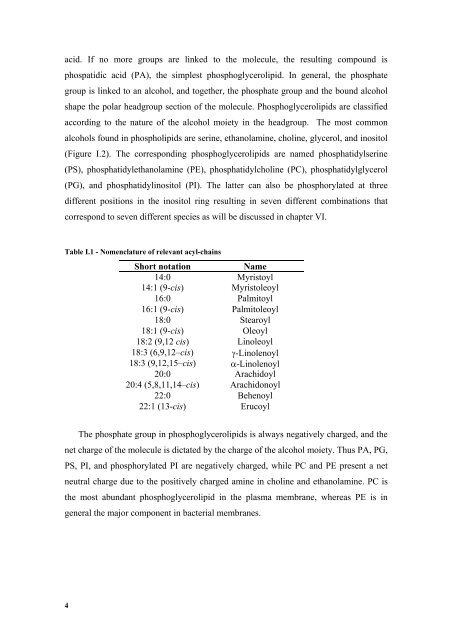Biophysical studies of membrane proteins/peptides. Interaction with ...
Biophysical studies of membrane proteins/peptides. Interaction with ...
Biophysical studies of membrane proteins/peptides. Interaction with ...
Create successful ePaper yourself
Turn your PDF publications into a flip-book with our unique Google optimized e-Paper software.
acid. If no more groups are linked to the molecule, the resulting compound is<br />
phospatidic acid (PA), the simplest phosphoglycerolipid. In general, the phosphate<br />
group is linked to an alcohol, and together, the phosphate group and the bound alcohol<br />
shape the polar headgroup section <strong>of</strong> the molecule. Phosphoglycerolipids are classified<br />
according to the nature <strong>of</strong> the alcohol moiety in the headgroup. The most common<br />
alcohols found in phospholipids are serine, ethanolamine, choline, glycerol, and inositol<br />
(Figure I.2). The corresponding phosphoglycerolipids are named phosphatidylserine<br />
(PS), phosphatidylethanolamine (PE), phosphatidylcholine (PC), phosphatidylglycerol<br />
(PG), and phosphatidylinositol (PI). The latter can also be phosphorylated at three<br />
different positions in the inositol ring resulting in seven different combinations that<br />
correspond to seven different species as will be discussed in chapter VI.<br />
Table I.1 - Nomenclature <strong>of</strong> relevant acyl-chains<br />
Short notation<br />
Name<br />
14:0 Myristoyl<br />
14:1 (9-cis) Myristoleoyl<br />
16:0 Palmitoyl<br />
16:1 (9-cis) Palmitoleoyl<br />
18:0 Stearoyl<br />
18:1 (9-cis) Oleoyl<br />
18:2 (9,12 cis) Linoleoyl<br />
18:3 (6,9,12–cis) γ-Linolenoyl<br />
18:3 (9,12,15–cis) α-Linolenoyl<br />
20:0 Arachidoyl<br />
20:4 (5,8,11,14–cis) Arachidonoyl<br />
22:0 Behenoyl<br />
22:1 (13-cis) Erucoyl<br />
The phosphate group in phosphoglycerolipids is always negatively charged, and the<br />
net charge <strong>of</strong> the molecule is dictated by the charge <strong>of</strong> the alcohol moiety. Thus PA, PG,<br />
PS, PI, and phosphorylated PI are negatively charged, while PC and PE present a net<br />
neutral charge due to the positively charged amine in choline and ethanolamine. PC is<br />
the most abundant phosphoglycerolipid in the plasma <strong>membrane</strong>, whereas PE is in<br />
general the major component in bacterial <strong>membrane</strong>s.<br />
4















